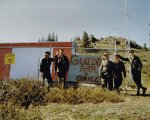I hope this thread isn't considered long dead, but I just stumbled apon it.
I have some experience here. I've worked with (or more correctly, lived with) Sr90-fueled RTGs in the USAF. They were hand-me-downs from the USN. They had outlived their useful life for the Navy mission, but still had enough life for our mission. I believe they had been used by the Navy to power a variety of unmanned equipment, including some remote lighthouses. The Rooskies used a butt-load of them for remote lighthouses, and eventually forgot where they put them all!! They are out there still, rusting away in the wilderness.
Nuclear (nuculer for you 'W'-heads) power plants use controlled fission to create huge amounts of heat while RTGs use passive decay to create a continuous small amount of heat. Two completely different technologies. Slightly mishandle one and you have a planet-wide disaster. Hit the other with a freight train and you have a derailed train.
Now then, as to whether the reactors in the OP were used to produce steam, I had my doubts. It would come down to whether it is more efficient and safer in a mobile platform to heat a thermal-electric pile that directly converts heat into a bit of electricity in a simple, compact, fairly safe and cool package with no moving parts...or extend water pipes through the scary bits to make steam to turn turbines making lots of juice, thereby increasing the complexity and failure modes. After taking another look at the newer vehicles in the 'englishrussia' link, those do appear to be mobile nuclear power plants and not RTGs, but I'm no thermodynamicist (though I did stay in a Holiday Inn last week).
Also, in my afterlife as a gov't contractor, I had some small involvement with a reactor technology exchange program between the Rooskies and US. The reactor we were interested in at the time was sort of a hybrid between a standard reactor and an RTG. Some details here, under the 'Topaz-II' heading...
TOPAZ nuclear reactor - Wikipedia, the free encyclopedia






